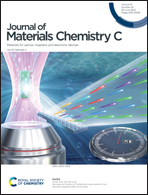Balancing fluorescence and singlet oxygen formation in push–pull type near-infrared BODIPY photosensitizers†
Abstract
Boron dipyrromethene dyes are highly attractive for image-guided photodynamic therapy. Nevertheless, their clinical breakthrough as theranostic agents is still obstructed by several limitations. Here, we report a series of strongly absorbing, heavy-atom-free, distyryl-BODIPY donor–acceptor dyads operating within the phototherapeutic window. Whereas diphenylamine and carbazole donors lead to strong fluorescence, dimethylacridine, phenoxazine, and phenothiazine units afford a decent fluorescence combined with the efficient formation of singlet oxygen. Dedicated photophysical analysis and quantum-chemical calculations are performed to elucidate the excited state dynamics responsible for the pronounced differences within the BODIPY series. Femtosecond transient absorption spectra reveal the nature of the excited state processes and the involvement of charge-transfer states in triplet formation.



 Please wait while we load your content...
Please wait while we load your content...